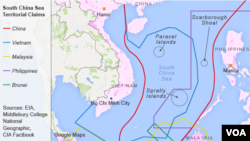The dispute over the strategic waterways of the South China Sea has intensified, pitting a rising China against its smaller and militarily weaker neighbors who all lay claim to a string of isles, coral reefs and lagoons mostly in the Spratly and the Paracel islands. Only about 45 of them are occupied. The area is one of the world's busiest shipping routes, rich in fish and potential gas and oil reserves, but it has now emerged as a possible flashpoint involving world powers and regional claimants.
A look at some of the most recent key developments:
Third airstrip?
New satellite images taken in early September purportedly show construction for a third Chinese airstrip in the South China Sea, this time on Mischief Reef, which would be of particular concern to the Philippines.
According to the Center for Strategic and International Studies, which released the latest images, the potential runway would be just 21 nautical miles (39 kilometers) from the Philippine warship BRP Sierra Madre, a World War II-era tank landing ship that was grounded by the Philippines in 1999 and became an outpost for a contingent of marines at Second Thomas Shoal.
Chinese coast guard ships have tried to block Philippine resupply convoys to the Sierra Madre, and Beijing has been putting pressure on the Philippines to abandon the shoal.
The other two Chinese airfields said to be under construction are located on Fiery Cross Reef and Subi Reef. Satellite images, also taken early this month, show grading work on Subi and laying down paint on Fiery Cross, indicating the work there was well advanced, CSIS said.
Fiery Cross sits in the western half of the Spratlys and the airstrip there would most directly challenge Vietnamese outposts, while Subi is just 15 nautical miles (28 kilometers) from the Philippine airstrip at Thitu Island and less than 40 nautical miles (74 kilometers) from Taiwan's only holding on Itu Aba.
CSIS said that a third airstrip on Mischief Reef would complete the triangle, significantly boosting China's air patrol and interdiction capabilities over the contested waters and features of the Spratlys.
Dilemma for US
The enlargement of reefs and construction of airfields challenges Washington's naval supremacy in the western Pacific.
Chinese President Xi Jinping is headed to a state visit to the U.S. and will be hosted by President Barack Obama at the White House on Sept. 25.
The Philippines, a U.S. treaty ally, last month asked the visiting U.S. Pacific commander to help protect the transport of Filipino troops and supplies to Second Thomas Shoal from Chinese harassment. Such a request is in line with Washington's commitment to secure unimpeded navigation in what it considers international waters.
Philippine Defense Secretary Voltaire Gazmin said Adm. Harry Harris Jr. assured him of U.S. readiness to provide assistance, adding that the U.S. military has flown an aircraft at least once when a Philippine boat delivered supplies last year to Filipino marines marooned on the rusty naval ship.
"If there are Americans flying around there, we won't be troubled," Gazmin said. "We need to be helped in our resupply missions. The best way they could assist is through their presence."
Harris has also indicated the U.S. may be able to provide a third U.S. Coast Guard cutter in addition to two earlier ones, which have become the largest frigates in the Philippine navy.
No threat to navigation
Speaking at an international naval security conference in London, Chinese Vice Adm. Yuan Yubai, commander of the People's Liberation Army Navy's northern fleet, was quoted as saying that the safety and freedom of navigation must be protected in the South China Sea.
He said that the South China Sea "is a sea for all the nations around, and a sea of peace."
Last word
"The South China Sea, as the name indicates, is a sea area that belongs to China." Vice Adm. Yuan Yubai, commander of the People's Liberation Army Navy's northern fleet.







